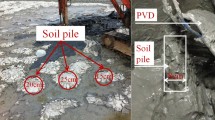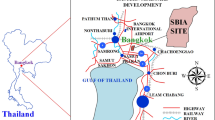Abstract
Laboratory tests and case history studies indicate that soil subjected to vacuum preloading may not behave the same as ground treated by traditional surcharge preloading. In detail, soil compression under vacuum pressure is smaller than or equal to that induced by positive pressure with the same magnitude; soil rebound after stopping the vacuum is not as high as after removing the surcharge; and the consolidation rate is usually faster under vacuum pressure than with surcharge preloading. Analysis of vacuum consolidation with existing methods cannot gain all these differences. Thus, in this study, three factors for adjusting compressibility and permeability are proposed based on past laboratory and field results which are used in a finite element analysis of soft soil foundation under vacuum-assisted preloading. This proposed method can be incorporated in existing computer programs associated with classical soil models (e.g., the modified Cam-Clay model and the Soft-Soil model); it is then examined via three distinct simulation scenarios including a laboratory model test and two prototype field cases. The improved accuracy in relation to consolidation by the proposed method is demonstrated and practical ranges for the adjustment factors are discussed.










Similar content being viewed by others
References
Indraratna B, Chu J, Rujikiatkamjorn C (2015) Ground improvement case histories: embankments with special reference to consolidation and other physical methods. Butterworth Heinemann, Oxford
Chu J, Yan SW (2005) Application of the vacuum preloading method in soil improvement projects. Elsevier Geo-Eng Book Ser 3:91–117
Indraratna B (2010) Recent advances in the application of vertical drains and vacuum preloading in soft soil stabilisation. EH Davis Memorial Lecture. Australian Geomechanics Society, pp 1–57
Chai J, Carter JP (2011). Deformation analysis in soft ground improvement, vol 18. Springer Science & Business Media, The Netherlands
Saowapakpiboon J, Bergado DT, Youwai S, Chai JC, Wanthong P, Voottipruex P (2010) Measured and predicted performance of prefabricated vertical drains (PVDs) with and without vacuum preloading. Geotext Geomembr 28(1):1–11
Saowapakpiboon J, Bergado DT, Voottipruex P, Lam LG, Nakakuma K (2011) PVD improvement combined with surcharge and vacuum preloading including simulations. Geotext Geomembr 29(1):74–82
Rondonuwu SG, Chai JC, Cai YQ, Wang J (2016) Prediction of the stress state and deformation of soil deposit under vacuum pressure. Transp Geotech 6:75–83
Indraratna B, Rujikiatkamjorn C, Ameratunga J, Boyle P (2011) Performance and prediction of vacuum combined surcharge consolidation at Port of Brisbane. J Geotech Geoenviron Eng 137(11):1009–1018
Imai, G. (2005). For the further development of “Vacuum-Induced Consolidation Method"-present understandings of its principle and their applications. In PROCEEDINGS-JAPAN SOCIETY OF CIVIL ENGINEERS (Vol. 798, p. 1). OKU GAKKAI
Chai JC, Carter JP, Hayashi S (2005) Ground deformation induced by vacuum consolidation. J Geotech Geoenviron Eng 131(12):1552–1561
Robinson RG, Indraratna B, Rujikiatkamjorn C (2012) Final state of soils under vacuum preloading. Can Geotech J 49(6):729–739
Wu Y, Xu F, Yuan M, Sun D (2016) Ground deformation induced by vacuum loading–unloading. Environ Earth Sci 75(3):1–8
Hattab M, Fleureau JM (2010) Experimental study of kaolin particle orientation mechanism. Géotechnique 60(5):323–331
Chai J, Jia R, Nie J, Aiga K, Negami T, Hino T (2015) 1D deformation induced permeability and microstructural anisotropy of Ariake clays. Geomech Eng 8(1):81–95
Gangaputhiran S, Robinson RG, Karpurapu R (2016) Properties of soil after surcharge or vacuum preloading. Proc Inst Civil Eng-Gr Improv 1–14
Indraratna B, Kan ME, Potts D, Rujikiatkamjorn C, Sloan SW (2016) Analytical solution and numerical simulation of vacuum consolidation by vertical drains beneath circular embankments. Comput Geotech 80:83–96
Brinkgreve RBJ, Swolfs WM, Engin E (2015) PLAXIS 2D User’s Manuals. Plaxis BV. Delft, The Netherlands
Terzaghi K, Peck RB, Mesri G (1996) Soil mechanics in engineering practice, 3rd edn. Wiley, Hoboken, NJ
Tavenas F, Jean P, Leblond P, Leroueil S (1983) The permeability of natural soft clays. II Permeability characteristics. Can Geotech J 20:645–650
Shi JY, Lei GH, Ai YB, Wei D, Song XW (2006) Research of settlement calculation for vacuum preloading. Rock Soil Mech 27(3):365–368
Peng J, Liu HL, Chen YH (2003) Mechanism of foundation strengthening by vacuum-surcharge preloading method. J Hohai University (Natural Sciences), 31(5):559–563
Kianfar K, Indraratna B, Rujikiatkamjorn C, Leroueil S (2015) Radial consolidation response upon the application and removal of vacuum and fill loading. Can Geotech J 52(12):2156–2162
Indraratna B, Perera D, Rujikiatkamjorn C, Kelly R. (2014). Soil disturbance analysis due to vertical drain installation. Proc Inst Civ Eng Geotech Eng 168:236–246
Indraratna B, Rujikiatkamjorn C, Kelly R, Buys H. (2012). Soft soil foundation improved by vacuum and surcharge loading. Proc ICE-Gr Improv 165:87–96
Berthier D, Boyle P, Ameratunga J, De Bok C Vincent P (2009) A successful trial of vacuum consolidation at the Port of Brisbane. Coasts Ports 2009 640
Li H, Gao YF, Liu HL, Peng J, Mahfouz AH (2003) Simplified method for subsoil improvement by vacuum combined with surcharge preloading. Chin J Geotech 25(1):58–62
Indraratna B, Rujikiatkamjorn C, Sathananthan I (2005) Analytical and numerical solutions for a single vertical drain including the effects of vacuum preloading. Can Geotech J 42(4):994–1014
Tran TA, Mitachi T (2008) Equivalent plane strain modeling of vertical drains in soft ground under embankment combined with vacuum preloading. Comput Geotech 35(5):655–672
Acknowledgements
This research is sponsored jointly through the 1st author’s Chinese Scholarship Council (CSC) fellowship at University of Wollongong, the National Natural Science Foundation of China (No. 51308309) and K.C. Wong Magna Fund in Ningbo University. The authors also appreciate the efforts of Cholachat Rujikiatkamjorn at University of Wollongong for his assistance during numerical simulation and language improvement.
Author information
Authors and Affiliations
Corresponding author
Rights and permissions
About this article
Cite this article
Deng, Y., Kan, M.E., Indraratna, B. et al. Finite Element Analysis of Vacuum Consolidation With Modified Compressibility and Permeability Parameters. Int. J. of Geosynth. and Ground Eng. 3, 15 (2017). https://doi.org/10.1007/s40891-017-0092-8
Received:
Accepted:
Published:
DOI: https://doi.org/10.1007/s40891-017-0092-8




